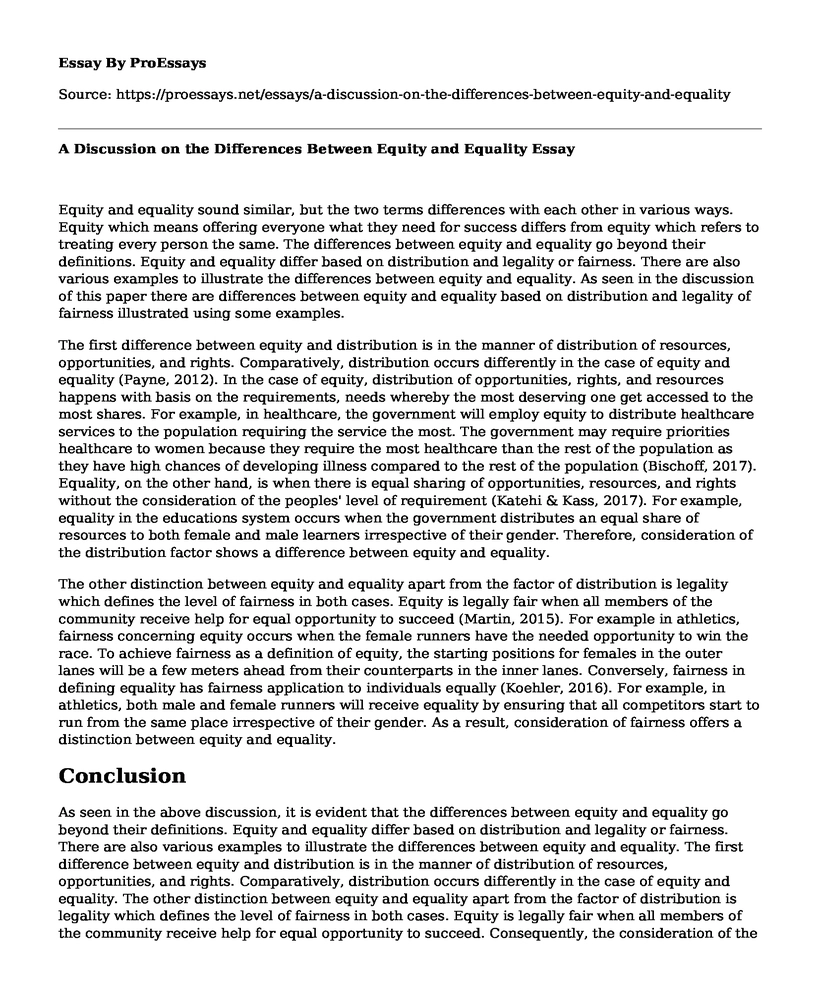Equity and equality sound similar, but the two terms differences with each other in various ways. Equity which means offering everyone what they need for success differs from equity which refers to treating every person the same. The differences between equity and equality go beyond their definitions. Equity and equality differ based on distribution and legality or fairness. There are also various examples to illustrate the differences between equity and equality. As seen in the discussion of this paper there are differences between equity and equality based on distribution and legality of fairness illustrated using some examples.
The first difference between equity and distribution is in the manner of distribution of resources, opportunities, and rights. Comparatively, distribution occurs differently in the case of equity and equality (Payne, 2012). In the case of equity, distribution of opportunities, rights, and resources happens with basis on the requirements, needs whereby the most deserving one get accessed to the most shares. For example, in healthcare, the government will employ equity to distribute healthcare services to the population requiring the service the most. The government may require priorities healthcare to women because they require the most healthcare than the rest of the population as they have high chances of developing illness compared to the rest of the population (Bischoff, 2017). Equality, on the other hand, is when there is equal sharing of opportunities, resources, and rights without the consideration of the peoples' level of requirement (Katehi & Kass, 2017). For example, equality in the educations system occurs when the government distributes an equal share of resources to both female and male learners irrespective of their gender. Therefore, consideration of the distribution factor shows a difference between equity and equality.
The other distinction between equity and equality apart from the factor of distribution is legality which defines the level of fairness in both cases. Equity is legally fair when all members of the community receive help for equal opportunity to succeed (Martin, 2015). For example in athletics, fairness concerning equity occurs when the female runners have the needed opportunity to win the race. To achieve fairness as a definition of equity, the starting positions for females in the outer lanes will be a few meters ahead from their counterparts in the inner lanes. Conversely, fairness in defining equality has fairness application to individuals equally (Koehler, 2016). For example, in athletics, both male and female runners will receive equality by ensuring that all competitors start to run from the same place irrespective of their gender. As a result, consideration of fairness offers a distinction between equity and equality.
Conclusion
As seen in the above discussion, it is evident that the differences between equity and equality go beyond their definitions. Equity and equality differ based on distribution and legality or fairness. There are also various examples to illustrate the differences between equity and equality. The first difference between equity and distribution is in the manner of distribution of resources, opportunities, and rights. Comparatively, distribution occurs differently in the case of equity and equality. The other distinction between equity and equality apart from the factor of distribution is legality which defines the level of fairness in both cases. Equity is legally fair when all members of the community receive help for equal opportunity to succeed. Consequently, the consideration of the distribution and fairness offers a difference between equity and equality.
References
Bischoff, G. (2017). Improving gender equality in the STEM environment: EESC recommendations. STEM Gender Equality Congress Proceedings, 1(1), 592-602. doi: 10.21820/25150774.2017.1.26
Katehi, L., & Kass, P. (2017). Equity Issues at the Intersection of Gender and Race in the United States. STEM Gender Equality Congress Proceedings, 1(1), 412-446. doi: 10.21820/25150774.2017.1.18
Koehler, G. (2016). Tapping the Sustainable Development Goals for progressive gender equity and equality policy?. Gender & Development, 24(1), 53-68. doi: 10.1080/13552074.2016.1142217
Martin, M. (2015). Satisfaction with the intimate exchange: Gender-role differences and the impact of equity, equality, and rewards. Sex Roles, 13(11-12), 597-605. doi: 10.1007/bf00287297
Payne, S. (2012). An Elusive Goal? Gender Equity and Gender Equality in Health Policy. Das Gesundheitswesen, 74(04), e19-e24. doi: 10.1055/s-0032-1311556
Cite this page
A Discussion on the Differences Between Equity and Equality . (2022, Oct 08). Retrieved from https://proessays.net/essays/a-discussion-on-the-differences-between-equity-and-equality
If you are the original author of this essay and no longer wish to have it published on the ProEssays website, please click below to request its removal:
- The Role of Business in Society - Essay Sample
- Essay Sample on Religion and Social Change
- Essay Example on Post-Racial America? Uncovering Racism's Lingering Effects
- Essay Example on 1960s London Working-Class Skinheads: Subculture & Racism
- Essay Example on Workplace Conflicts: Causes & Factors
- Free Paper on Genetic Engineering: Creating an Improved Version of Humans
- Free Research Paper Sample on Advanced Driver Assistance Systems







